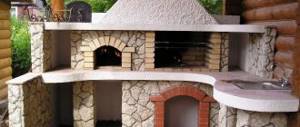Maintaining a positive temperature in the garage is necessary not only for the comfort of its owner, but also to ensure the safety of the car. Therefore, the question of how to heat a garage: with electricity, gas or wood always remains relevant. A network connection is almost always available in a given room, but using this resource is not a very economical method of heating. Equipment operating on solid fuel requires the constant presence of the user to ensure timely loading. As a result, gas heating remains, which is worth considering in more detail.
Specifications
As a rule, utility networks are not connected to the garage, so gas in cylinders is used for heating
The main characteristics of gas heaters for garages include:
- type of device (IR, convector, catalyst, etc.);
- developed thermal power in Watts;
- installation method (wall or floor);
- dimensions and weight;
- life time.
Each of the indicators under consideration fully characterizes a particular model and helps to choose a unit suitable for the garage.
Advantages and disadvantages
The advantages of gas heaters for garages powered by a separate cylinder are:
- compactness and mobility;
- low cost of the equipment itself and fuel for it;
- availability of energy sources;
- environmental friendliness (no combustion waste);
- ease of operation;
- long service life (15–20 years);
- speed of heating the room.
The operational safety of this heating method is beyond doubt if the necessary precautions are taken when using gas, which involve organizing effective ventilation (forced or natural).
The danger of an explosion of a gas mixture can be considered a disadvantage of the units under consideration only if the rules of their operation are violated.
Types of gas heaters
All types of gas heating devices for garages are divided into two types of models:
- wall;
- mobile floor.
The first option is usually carried out in the form of a powerful convector for main gas, more precisely a mixture of gases produced and transported through a gas pipeline, in which methane predominates. He needs to supply a pipe with fuel and make a smoke exhaust.
Such devices are installed very rarely in garages. A compact mobile analogue, designed to operate from a cylinder, is cheaper, easier to install and does not require approvals for connection.
A private garage usually has a small area, so small-sized and cheap propane appliances are most often chosen to heat it.
According to the design and principle of operation, gas heaters are infrared and convection. To stimulate the movement of heated air, convection models may or may not be equipped with a fan. Each of these types has its own advantages.
Option #1 – infrared
The operation of IR heating devices is based on the principle of “thermal radiation” of electromagnetic waves with a length in the region of 9.2 microns. Such infrared rays calmly pass through the air in the room without delay and heat the surfaces opposite the heater. And from the walls, ceiling and various objects, heat spreads further throughout the room.
Radiation from a gas IR heater in a garage is absolutely safe for humans; even with prolonged exposure, it is not capable of causing damage to a car.
The source of radiation in an infrared gas device can be a direct open flame or a ceramic heating element that receives energy from the burned fuel. Next, the IR rays are directed in the desired direction using a reflector.
Infrared gas equipment for space heating:
- does not require electricity to operate;
- differs in compact sizes;
- economical;
- silently;
- does not create convection and does not raise dust.
The basic disadvantage of IR gas heaters for arranging a garage or cottage is a narrow beam of heat. After switching on, the infrared emitter heats only those surfaces in the treated space where it is directed.
At the same time, walls and objects outside the range of the device remain cold without direct heating. As a result, a situation is possible where one corner of the room is heated and comfortable for car repairs, while cold is coming from the other.
Gas IR heaters are found in stores in the form of heating pyramids. You shouldn’t take such models for a garage; they are designed for heating open spaces and spacious rooms
For small garages, propane-powered infrared devices in the form of ceramic stoves with a cylinder inside or compact emitter panels are most suitable. Both options usually have an oxygen and gas leak sensor, as well as fire protection. The power of such equipment is designed for heating garages ranging from 4 to 40 square meters. m.
Option #2 - catalytic
In catalytic infrared gas heaters, heat is generated due to the effect of catalysis - the oxidation of gas on a heating surface coated with platinum. There is no open flame as such. But as a result, propane “burns out” much more completely than in the case of a classic burner.
In terms of efficiency and power, catalytic and infrared gas heaters for garages are similar, but in terms of safety and environmental friendliness, the former are much superior to the latter
During operation, the heating element of the catalytic device heats up to 200 0C. At the exit, ordinary CO2 and H2O are formed, but oxygen is consumed several times less than during open combustion of gas fuel. Plus, as a result, propane burns out almost completely and without the formation of carbon monoxide CO.
Catalytic infrared heater:
- economical in fuel consumption;
- does not form carbon monoxide when heating;
- fireproof;
- favorable for breathing, oxygen burns in the garage to a minimum.
The main disadvantage of such a device is its short service life. The catalyst in it is designed for continuous operation in the region of 2–2.5 thousand hours. This is about five to six months, and after that the heater can be thrown away. It will be enough for one winter season, but no more.
Option #3 – convectors
Convector gas heaters for garages have a ceramic or steel heat exchanger inside, which is heated by an open flame and then transfers heat to the garage using natural air convection. Such a device has holes at the bottom for the intake of cold air, and at the top for the exit of hot air.
Convectors take a long time to warm up the garage space, but then effectively and with a minimum of fuel waste maintain the set temperature
Gas burners for space heating: types of devices
To heat any room, you can use heaters that will quickly raise the air temperature and make staying in the room comfortable. For garages, a portable gas heater that runs on liquefied fuel is often used.
Advantages of gas heaters:
- Quick heating of the room;
- Compactness;
- Saving electrical energy.
A portable heater is convenient because it can be placed in any desired place or moved to another room at any time.
According to their design, gas heaters are divided into two types:
- With an open type chamber - they have special safety valves and air analyzers that prevent gas from escaping into the room;
- With a closed type chamber - such devices are safer and more reliable, since gas does not have the opportunity to enter the room.
To use various gas boilers and furnaces, permission from the relevant services is required. You will also need a separate boiler room for placement, since installing gas equipment in the same room as a car is prohibited!
If there is no need to heat the garage constantly, you can use gas cylinders and various heating devices. The volume of the cylinders can be calculated based on the planned mode of use and the power of the connected devices. Such cylinders should be stored in an insulated metal cabinet located above floor level.
Gas heaters are divided into:
- Infrared with ceramic burner;
- Convectors;
- Heat guns;
- Catalytic devices.
The latter do not have a flame, since the gas is oxidized by oxygen, releasing heat. And platinum or other elements of this group act as a catalyst. Such heaters are lightweight, easy to operate, but at the same time very fire hazardous.
Infrared burners heat surrounding objects, which release heat into the air. A very effective and affordable method of heating a garage space.
As for convectors, they burn natural gas or gas from a can in a closed chamber. The main condition is that there are no drafts! In this case, combustion air is most often taken from the street and decay products also come out there, so there are no problems with burning out oxygen and the risk of carbon monoxide poisoning.
Safety precautions
When using a gas heater, the garage must be ventilated.
Gas heaters are devices during the operation of which it is important to comply with the following safety requirements:
- It is not allowed to cover the working part of the device with cloth items, which are sometimes hung out to dry;
- the garage space must be ventilated;
- When using the unit, it is prohibited to remove the protective grille;
- It is not allowed to direct thermal radiation at flammable liquids, as well as cloth and paper objects.
If the user manual specifically specifies the operating position of the unit, it is not allowed to change it to another placement option.
Ensuring tightness and installing the chimney
If you are making a potbelly stove with your own hands from a gas cylinder, then at the next stage you need to install curtains, and then weld them to the holes. The door is covered with asbestos-cement cord, which will guarantee excellent tightness. We should not forget that the holes for the chimney still need to be made. Through the hole located in the top cover, exhaust gases will be removed and oxygen will be supplied. Its dimensions must correspond to the diameter of the pipe. You can also provide side smoke exhaust. In this case, you need to work on the side of the body. Experts in some cases advise to equip the knee, but you can draw the conclusion quite directly. If the cylinder has lost its upper part, then the chimney can be installed on top.
Review of industrial models
Gas equipment, like a diesel garage heater powered by diesel fuel, is not recommended to be made independently. Experts advise purchasing industrial devices from a trusted manufacturer. The international holding Ballu Industrial Group with representative offices in 6 countries, including Russia, China and Japan, has proven itself well in the domestic market.
Another well-known company Kovea from South Korea specializes in gas equipment, almost half of which is sold on the Russian markets. The well-known Swedish concern Timberk, which produces modern water heaters, as well as heating and climate control equipment, is equally popular.
An example of a model designed specifically for the garage is the ceramic heater TGH 4200 X1, which has a floor stand. HPV GmbH is not a well-known company to most Russians. A sample of its products is the portable IR heater “4200 ZS” with a power of 4.3 kW.
Homemade gas heaters for the garage
Homemade heater
The main advantage of such a device is that its manufacture does not require expensive branded parts. In this case, it is possible to make do with improvised components available to any garage owner.
Preparation of materials
To make a gas heater you will need to prepare:
- branded burner with valve;
- sheet of tin of suitable size;
- tin scissors;
- electric drill with a set of drills;
- riveter and rivets for it.
To make a protective grille, you will need a piece of fine-mesh metal mesh of the desired shape.
Assembly of the structure
The structure is assembled as follows:
- On the sheet metal blank the outline of the future heater body with four rectangular ears is drawn.
- According to the markings, a workpiece is cut out with sections that do not have burrs.
- The burner is attached to the curved pipe-shaped body with ears using bolts.
- The ears at the other end are used to secure the protective mesh.
As a result of the assembly, a heater with tin walls and working ends is obtained.
How to make a potbelly stove from a gas cylinder: general principles
To work, you will need a welding machine, a tool for cutting and drilling metal, sheet steel with a thickness of 3 mm, fittings, an angle or pipes for installing a support frame (for a horizontal stove), and pipes for the chimney.
A stove made from a gas cylinder can be equipped with a ready-made stove door by cutting a suitable size hole in the body and welding strips of metal around the perimeter so that there are no gaps between the door frame and the cylinder.
Installing the door on a gas cylinder
The second method is to cut a rectangular hole in the cylinder, and the cut out fragment of the wall serves as the firebox door. It is hung on welded hinges; a strip of metal can be welded on three free sides to cover the cracks. The valve is also welded on.
It is advisable to make the chimney from the stove to the exit into the street broken, consisting of several elbows, otherwise the main part of the thermal energy will immediately go outside through the pipe, without having time to heat the room. It is important that the knees are not at a right or negative angle, otherwise there will be no traction.
How to make a vertical stove from a gas cylinder?
At any convenient height, a firebox opening is cut into the cylinder (about 30x20 cm), and a blower opening is placed below (about 20x10 cm).
For such a stove it is necessary to make grates. The grate is welded from reinforcing bars; it is better not to fasten it tightly inside the stove, but to place it on scraps of corner welded to the walls - if the grates burn out, it will be easier to replace them.
Vertical stove with grates
The convex upper part of the cylinder can be cut off and a circle of sheet metal welded in its place. This hob is convenient for heating food or tea. In this case, a hole for the chimney is made in the side of the stove and a short horizontal elbow is installed. If there is no need for a “tile,” a hole for the chimney is drilled at the location where the gearbox is installed.
A vertical stove is convenient to use if the room is small and there is no extra space. Such a homemade potbelly stove does not require the installation of a supporting structure, so it is easy to move and install as a temporary heat source, for example, for heating a greenhouse during periods of low temperatures and frosts.
Horizontal stove made from a gas cylinder
An opening for the firebox is cut out in the end part of the cylinder, and a door is installed. Grates are usually not installed inside a horizontal stove so as not to waste useful space. Instead, holes in 5-6 rows are drilled in the lower part of the horizontal stove, and a flat sheet metal box is welded on the outside - it will serve as an ash pit.
Read also: Pre 7 hammer drill instructions
Horizontal stove
The stove body is mounted on a frame welded from suitable steel pipes or angles. It is recommended to prepare design drawings in advance, calculating the optimal dimensions of all external elements.
By welding a small metal sheet on top of the body, you can get a convenient cooking surface.
A horizontal potbelly stove made from a gas cylinder with your own hands is suitable for a garage, a country house, it can be installed in a bathhouse if you build a heater.
Increasing efficiency
A potbelly stove made from a gas cylinder has a significant drawback: the fuel in it burns out quickly and the bulk of the thermal energy goes outside.
In addition to lengthening the inside of the chimney, you can increase the efficiency of the stove in other ways
:
- Mount an external metal casing with holes in the lower and upper parts - due to intense convection, the air in the room will warm up faster.
Potbelly stove in a metal casing- Weld metal strips (ends) or pipes to the stove body, creating convective fins.
- Cover the stove with brick - the structure will take longer to warm up, but at the same time give off heat more evenly and for a long time. In addition, the risk of accidentally getting burned is reduced.
- Mount a metal mesh on the stove body or around a vertical pipe and fill it with stones. This is the principle used to make a sauna stove; the stones (like the brick in the previous version) act as a heat accumulator. To prevent stones from bursting when overheated, it is necessary to choose a material with a homogeneous, non-layered structure, without inclusions. Please note that some rocks emit radon, especially when heated. It is better to purchase stones for the stove in a specialized store.
Cylinder in a mesh of stones- Install a water jacket on the chimney and mount a circuit for supplying coolant to the radiators - in this case we get a heating boiler from an unnecessary gas cylinder. Such a system will be more efficient when using a pump for forced circulation of coolant. And we must not forget about the expansion tank, the volume of which must be at least 10% of the volume of liquid in the system.
- Water circuit
But the highest efficiency is for a stove made from a propane cylinder if it is a pyrolysis stove, the manufacture of which will also be discussed in this article.
Manufacturing of a pyrolysis furnace
In such a stove, fuel combustion occurs slowly, since only its top layer burns. At the same time, flammable gases released during smoldering of the fuel are burned in the upper chamber. Such a long-burning stove made from a gas cylinder economically consumes fuel and allows you to extract maximum thermal energy from it.
Pyrolysis stove from a gas cylinder
A pyrolysis oven made from an old gas cylinder consists of the following elements
:
- Fuel tank (a cylinder with the top part cut off, it can be increased in height by 30-40 cm by welding part of the same cylinder, such a stove will work longer on one load of fuel);
- Cover with a hole for the air intake pipe;
- An air intake pipe with a weight platform dividing the furnace into chambers.
The top part of the container is cut off and a metal strip is welded around its circumference to obtain a tight-fitting lid. A hole is cut in the lid in the center for the air intake pipe - it should move freely vertically, but at the same time it is advisable to leave a minimum gap.
A hole is cut for the chimney pipe just below the lid. The elbow must be removable, since the chimney of such a stove requires regular cleaning.
Note! It is difficult to make perfectly round holes for a removable chimney and air intake pipe, so it is most convenient to turn a metal washer with a suitable internal diameter on a lathe and weld it hermetically in the place where the hole is drilled.
The length of the air intake pipe should be 10-15 cm greater than the height of the firebox with lid. A round plate with a hole in the center is welded to the bottom of the pipe. The diameter of the plate should be slightly smaller than the internal diameter of the cylinder - flammable gases will penetrate through the gap into the upper part of the firebox. The thickness of the plate is from 6 mm, otherwise it will have to be additionally reinforced on top with stiffeners made of strips of metal.
Read also: Decoding the brand of electrodes for welding
6 blades from curved metal strips are welded from the bottom of the plate. In the center, on top of the strips, attach a small disk made of the same sheet metal, and drill a hole in it in the center.
The easiest way to regulate the intensity of fuel combustion in such a DIY stove is to install a valve in the form of a round metal plate with a bolted connection on the top of the air intake pipe.
Conclusion
A homemade stove from an empty gas cylinder is an economical option that allows you to solve the problem of how to heat your country house, garage or workshop for quite a long time.
In winter, potbelly stoves are often used. There are several ways to create a stove from a gas cylinder, using various materials and means.
The horizontal device is used for cooking and heating small spaces. A vertical potbelly stove is installed in garages, utility rooms and small buildings.
Diesel heater for garage
The third option will be a way out of the situation for those who do not have the opportunity or desire to purchase an electric or infrared heater model, and a gas heater cannot be installed in a garage for safety reasons. In this case, you can take an intermediate solution and use devices that run on liquid fuel, such as diesel or gasoline. Moreover, the first option is more popular. It is also compact, reliable and practical to use.
Prices for diesel garage heaters
Many people have a logical question: what to do with the combustion products obtained during the operation of diesel fuel. To solve this problem, modern diesel garage heaters use a special device that cleans the air of impurities. As a result, completely clean air comes out.
According to experts, the most suitable option for a garage would be to purchase diesel guns. But they also require a careful approach. Despite their effectiveness, they lead to a decrease in oxygen, which also needs to be taken into account. Therefore, when choosing a diesel gun as the main heating device, you should consider and equip a fresh air ventilation system. This will ensure the necessary air circulation with fresh air.
Advantages of diesel heaters
- The main advantage lies in the three-stage protection mechanism, which is quite optimally worked out. Inside the gun there is a built-in electronic system that autonomously controls excessive heating of the equipment and the force of the flame.
- Many diesel heaters use special sensors. Their purpose is to record temperature values at the most remote point in the garage. Based on these data, the equipment independently determines the need to increase or decrease the heating intensity.
- As mentioned, the combustion products of diesel fuel are not released into the air, but are filtered from it using a special heat exchanger.
- An increasing number of installations are equipped with automatic control systems, which minimizes the need to monitor the operation of the heating device.
What you should pay attention to when choosing a diesel heater
- It is preferable to opt for models based on platforms and equipped with wheels. It is much more convenient to relocate such an installation and install it in the area of the garage where it will be most needed.
- If you decide to purchase a diesel heater, you should take care of electricity. This is necessary for the operation of the fan, which helps distribute heat from the gun.
- It is advisable to use a model with a mechanical control panel, with which you can easily control the air heating power and the amount of fuel consumption.
Liquid fuel heating stoves
Liquid fuel stoves for heating garages are very popular among domestic car owners. The main types of fuel for such heaters are diesel fuel and waste, which are in the arsenal of most garage owners.
Advantages of liquid fuel heaters:
- high efficiency with small overall dimensions;
- the ability to work on almost any liquid fuel, provided that it does not contain moisture.
Flaws:
- fire hazard;
- high fuel consumption;
- high concentration of combustion products in the air.
On this topic:
Heating system installation
Choosing a circulation pump for heating a summer house
Install a ceramic tandoor stove at your dacha
Infrared heaters: types and selection rules
BACK FORWARD 1 of 9
Let's consider the design features of test heaters and homemade diesel heaters.
Heaters under development
It is very simple to assemble an effective, working furnace for the garage with your own hands, because it consists of only three elements:
- The lower container, which serves as the primary combustion chamber.
- The upper tank in which combustion of flammable gases formed during heating of the fuel occurs.
- The afterburner is a perforated tube connecting the lower container and the upper tank. Through the holes, air enters this element, which mixes with flammable gases and enhances their combustion.
The drawing shows in detail all the elements of the furnace and the order of their assembly.
Diesel stoves
Diesel stoves for the garage can be purchased or made by yourself. Ready-made models will cost the car owner more, but will significantly save time on manufacturing the unit. To create such a heater yourself, a dropper stove is ideal, the drawing of which is presented below.
The dropper design consists of the following elements:
- a bowl installed inside a steel pipe;
- a tube for metered fuel supply is installed on top of the bowl;
- An air pipe with holes (afterburner) is mounted in the center of the pipe.
The principle of operation of such a furnace is simple: fuel drops into a heated bowl, where it instantly burns, releasing thermal energy and some of the pyrolysis gas, which mixes with air and burns in an afterburner. Fuel is supplied by gravity or by means of a valve installed in the fuel line gap outside the installation housing.
Design advantages:
- relative safety of operation;
- high efficiency.
Flaws:
- the need to arrange a chimney and provide draft through high-quality supply ventilation;
- the smell of combustion products while the stove was in operating mode.
You should know that the “dropper” works very successfully, both on diesel fuel and on any types of engine oil and waste.
Reliable IR Heater Brands
When choosing a quality heater, the country of manufacture plays a big role. High-quality installations are produced by European and Russian companies. Chinese manufacturers often offer inexpensive but unreliable options. You can purchase wall-mounted electric infrared garage heaters from the following companies:
- EcoLine;
- Mister-Heath;
- IcoLine;
- UFO;
- Daewoo;
- Peony.
It is easy to warm up a room using these models of devices. The simple design allows you to do the installation yourself. The package includes brackets for installation to the wall or ceiling of the box. Household models have a minimum power of up to 2 kW. The productivity of the industrial version is much higher. One installation is enough to heat rooms from 80 to 100 cubic meters. If necessary, several units are connected to a common network with one or more thermostats. Automatic heating systems are produced by large-scale manufacturers of climate control devices:
- Starprogetti;
- Heliosa;
- Hyundai;
- Zilon.
IR heater
If the garage is small and made of iron, then there is no point in installing industrial installations. To obtain the optimal temperature, you need to install two heaters with a power of 1 kW.
Recommendations for masters
When making a stove from a cylinder with your own hands, you need to take into account several nuances. It is necessary to adhere to the basic recommendations and operating rules:
- the chimney should consist of broken sections, since all the heat will quickly escape through a short pipe;
- fuel can be anything - coal, firewood, wood waste, household waste;
- the efficiency increases with increasing chimney length, but straight and downward sections must be avoided;
- heat transfer increases if another container is placed inside the main body, but of a smaller size. This way you can increase draft and prevent smoke from entering the room.
At home, you can make a stove from a gas cylinder for heating small spaces. This is an economical design that allows you to heat a small country house or quickly prepare food in a few hours.
More information about a wood-burning stove made from a gas cylinder:
Since moderators don’t delete topics with stoves/stoves, then I’m here for you! I apologize in advance to those who have already seen this topic in other communities and to those whose underpants are burning from one type of foolishness with propane tanks. Thank you.
A little introduction. It all started with the fact that the use of free electricity had come to an end, and visiting the garage on winter evenings was not planned to be completed until spring. Therefore, in haste, so to speak, this wonderful heating device was made.
I would like to note that this was the first time I took up welding, so you can write as much as you like about the quality of the seams and the rest because I was overly pleased with myself)
How to correctly install infrared heating in a garage?
First you need to understand why you need electric heaters. If you want local heating to create and maintain a temperature of +5 degrees in a room of 20 square meters, then it is better to buy a 1 kW power emitter. The ideal option would be to place it above the hood of the car. The power can be calculated using the formula 50 W = 1 square meter. Main heating is calculated using the formula 100 W = 1 square meter. You need to make an accurate calculation of the heated area in advance.
After this, find out the power of the equipment. To the amount received, add 10% for possible heat loss. If the garage has 20 square meters, then you can install one 2 kW emitter or two 1 kW emitters. The manufacturer separately indicates on the packaging the required distance from the radiation source to the heated parts. This way you can install the equipment correctly. Household devices are mounted at a distance of approximately 1.5-2 m from the vehicle.
Installation of infrared heating in a garage
Advantages and disadvantages of IR
Garage IR heater equipment, technical indicators and features of use have specific advantages and disadvantages.
Advantages:
- connecting equipment does not require large financial investments;
- the basic package consists of the necessary parts for installation;
- simple connection of an electric emitter;
- installation of gas equipment may require obtaining the necessary permit;
- the possibility of separate zones of the room, rather than the entire garage;
- modern models are protected against overheating of the surface and fire in the event of a fall.
Minuses:
- the power of household appliances is much reduced in order to obtain favorable heating conditions;
- the high cost of the device and the large number of Chinese counterfeits that fill the climate system market.
The IR heating system has no analogues. Compared to a standard heating radiator, they allow you to get instant heating even in a cold building. High efficiency and almost no significant disadvantages explain the popularity of infrared emitters.
Manufacturers and popular models: ranking of the best and prices
A review of the best models from well-known manufacturers will help you navigate the range of infrared heaters.
Ballu BIH-LW-1.5
Compact device for local heating of small rooms (up to 25 m2). The heating element is a quartz tube. Control is carried out via a remote cord. Supplied with brackets for wall or ceiling installation.
The secrets of the popularity of a potbelly stove from a cylinder
An old and unnecessary gas cylinder is a suitable housing for a future furnace. But in order for a potbelly stove to effectively heat the room, you need to choose the right size of container. Five-liter cylinders are very small; their volume is not enough to create heat even in a small room. Cylinders of 12 and 27 liters can be used for heating small rooms, however, such stoves will be low-power. The most suitable option is a 50-liter gas (propane) cylinder.
If you happen to have a forty-liter industrial gas tank at hand, then it can also be used as a housing for a potbelly stove. However, it should be borne in mind that the walls of such a cylinder are thicker and the diameter is smaller.
The power and heating speed of the furnace directly depends on the size and thickness of the walls of the cylinder. The optimal tank volume for a potbelly stove is 50 liters.
Before using a gas cylinder, it is prepared for use; for this you need:
- unscrew the tank valve;
- leave the cylinder overnight and allow the remaining gas to escape;
- turn the container upside down;
- drain the condensate and collect it in unnecessary containers;
- fill the container with water to the very top;
- turn over and drain.
Before starting work on creating a potbelly stove, the gas cylinder is cleaned of gas residues. Otherwise, an explosion and unpleasant consequences may occur.
This stylish potbelly stove can be built from a regular gas cylinder
Potbelly stoves are simple, small-sized stoves designed for heating small rooms that, for some reason, cannot be heated by a full-fledged engineering system. Most often, units of this type are made of metal and are used in garages, sheds, country houses, greenhouses and change houses.
Making a stove from a gas cylinder has a lot of positive aspects:
- the thickness of the walls of the container is more than 3 mm, which is quite enough to ensure the rigidity and strength of the structure;
- Vessels for storing gases are made of high-alloy steels that successfully resist corrosion. In addition, sufficiently thick and high-quality metal guarantees that the walls of the potbelly stove will not burn out for a long time;
- minimal modifications will be required. Since there is no need to manufacture the furnace body, the time for building the heating device is reduced;
- Even if you buy a container for household gas, its cost on the secondary market is only a few hundred rubles. Most often, you can get a cylinder completely free of charge by asking around among your acquaintances and friends;
- from the point of view of heating engineering, the cylindrical shape of the firebox is optimal, therefore a potbelly stove made from a vessel for household gas is economical and highly productive;
- the existence of several structures, among which are horizontal and vertical units of direct or pyrolysis combustion;
- very fast heating of the room both due to radiation and convection.
The disadvantages of a heat generator built using a gas cylinder are inherent in all potbelly stoves. Firstly, the walls of the heating device become red hot, which in no way contributes to the safety of the unit. Secondly, it is impossible to guess the exact amount of firewood in order to somehow regulate the heating temperature.
Most often, 50-liter propane cylinders are used to make potbelly stoves.
I would also like to note not a minus, but rather a feature associated with the fact that gas cylinders are painted with ordinary enamel. At high temperatures, the paint will burn out, filling the room with toxic smoke. To eliminate the possibility of poisoning, you will have to remove the top coating mechanically or conduct the first two or three fires in an open space.
DIY IR heater
For those who want to make their own analogue of an infrared heater, here are several simple options for making them yourself.
There are many proposals posted on the Internet, both practical and fantastic. Here are some of them. First, how to repair an old Soviet infrared reflector. If the dish is intact and was not used for an improvised TV antenna, you need to check the integrity of the power cord, plug and connection to the spiral connection terminals. To make a spiral, first measure the length of the spiral winding onto the ceramic reflector cone. The nichrome thread is then wound in 2mm increments onto a steel rod of approximately the same length as measured on the cone. After winding, the nichrome is removed and in a free state (without interturn short circuits) is placed on a fire-resistant dielectric. Any glazed ceramic plate will do. And the electric current from the outlet is connected to the ends of the spiral. After heating, the spiral is turned off, placed in the groove of the ceramic cone of the reflector and connected to the power terminals.
The second, well-known option is to fill a metal box of cream or shoe polish with a mixture of quartz sand and graphite dust in a 50:50 ratio. First, the inside of the box is cleaned until it shines. Two 1.2 mm holes are made in the side wall. Two round pieces of tinned (food grade) tin are cut along the inner diameter. A wire with a cross-section of about 1.2 mm is soldered to them.
The first layer of the mixture is filled to half the depth of the jar, the first plate is laid, and the wire is brought out into the first hole. The second sand-graphite layer is added, a little not to the top. The second plate is laid and the wire is brought out into the second hole. Add heaping amounts of the rest of the mixture. The lid fits tightly. It is necessary to ensure pressure on the contents.
The heater power increases with increasing pressure. It operates on 220 V or lower voltage. When sintering the contents, just knock on the box. The principle is the same for boxes of all sizes.
Main types of oven
A vertical stove is made more often, as it takes up little space and has a neat appearance.
The horizontal design is valued due to the large cooking surface area. The dimensions of the ash pan and the hole for storing firewood in any device are 10x20 and 20x30 cm, respectively. Their markings are applied both to the drawings and to the cylinder itself - this makes it easier to cut out. The location of the holes is chosen arbitrarily, depending on the type of stove.
With the help of such a stove you can heat the room and even cook food outside
The chimney is made from a steel pipe, cutting it into different sections and welding them together. Additionally, you need to insulate it with mineral wool and foil. You can use the finished potbelly stove indoors or outdoors. If the stove is used for cooking outdoors, then it is enough to attach a low pipe for the smoke to escape.
Vertical stove
To create a vertical stove from a propane cylinder, it is placed vertically. It is necessary to cut off the neck, use a marker to draw the markings of the ash pan, chimney and firebox. The holes are cut with a grinder or cutter. Reinforcing bars are cut into identical pieces, forming grate bars. They are welded to the body in parallel rows or in a snake. Hinges for doors are attached, doors are cut out of steel sheet or cast iron. A sliding mechanism or latches are welded to them.
Read also: Formula for series connection of resistors
A hob is necessary if food will be cooked or water will be heated on the stove. To create it, you need to cut out a metal part of suitable size and weld it to the top of the cylinder. After this, all joints and seams are checked for tightness and strength, cleaned and sanded.
The vertical oven is more popular because it takes up less space
The hole for the chimney should be located at the top of the cylinder or on the side, sometimes the pipe passes through the central opening. In the side part, the elbow is first attached, then the chimney itself. Smoke and combustion products come out through the pipe. A metal stand or strong legs are attached to the bottom of the cylinder. Additionally, you can prepare the foundation for the potbelly stove.
Horizontal design
The first step is to create a strong stand. It is made of metal, the legs are welded, and then the body of the finished stove. A marker on the cylinder marks the location of the blower, chimney and fuel holes. The openings are cut with a chisel, grinder or cutter. Using a drill, holes are drilled in the lower part of the body. An ash pan is attached to the top; it is made of strong, heat-resistant metal. A damper is welded to the opening, which will serve as a blower.
The door is prepared from the cut out part of the cylinder. It must be scalded and attached to the body using hinges. Although you can make a cast iron door with a latch and weld it. The chimney should exit from the top rear of the stove. A steel sheet is laid and secured on top of the body to create a flat cooking surface.
A horizontal stove will require more space - this is its main disadvantage
You can buy ready-made burners in the store, cut a hole in the steel for them and secure them. This way you can make a stove from a horizontal gas cylinder, but it takes up a lot of space.
Rules for safe operation of the oven
In order not to cause a fire, you need to choose a location for installing the stove.
The following rules should be followed:
- The structure is placed where there are no drafts and away from light flammable objects that could be accidentally thrown into the oven by a gust of wind.
- There should be free space around the stove - 0.5 m on all sides.
- Ideally, the structure should be placed on a sheet of asbestos, metal or other non-combustible material.
- Fuel, wicks, etc. should be stored as far as possible from sources of fire.
A fire extinguisher is a must in a garage, and skimping on one is life-threatening. It is worth buying a reliable, non-volatile automatic model.
The volume of a fire extinguisher for a garage is selected with a reserve so that there is one and a half times more gas than is needed to extinguish a fire in a room of such cubic capacity.
On our website there is a selection of articles describing technologies for assembling various stoves for the garage; we recommend that you read:
- Do-it-yourself oven for the garage: a step-by-step design guide
- How to make a Buleryan oven with your own hands: step-by-step instructions for making
- Do-it-yourself potbelly stove from a gas cylinder: diagrams, drawings + step-by-step guide
Design features of brick kilns
Despite the simplicity and abundance of design solutions for garage heaters using liquid fuel and wood waste, brick stoves have earned respect from car owners due to a lot of advantages:
- Relative fire safety.
- Long-term maintenance of room temperature due to the high heat capacity of brick.
- Practicality. Heating equipment can be easily equipped with a hob.
- Minimum operating costs.
The disadvantages are:
- complexity of masonry;
- long heating;
- high cost of refractory bricks.
It will not be difficult for a person who has encountered such work to make a brick oven for a garage with his own hands: drawings, procedures and descriptions of the stages of constructing the structure can be easily found on the Internet.
Construction stages:
- We are preparing a place for the structure. To heat a standard garage, a stove with overall dimensions of 600x600 mm is sufficient. The best place is at the back wall of the garage, where the structure will not interfere with the entry of vehicles.
- We prepare the drawing.
- We purchase materials and prepare the necessary tools.
- We are preparing the foundation. If the weight of the masonry does not exceed 500 kg, then you can do without arranging an additional base.
- We build the structure using the selected masonry scheme.
An example of the order is presented below.
Laying a brick oven requires experience and specific skills. That is why we recommend turning to professionals for the construction and commissioning of such a structure.










